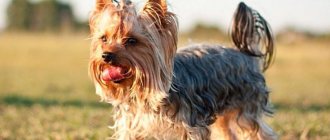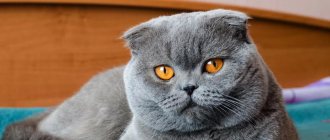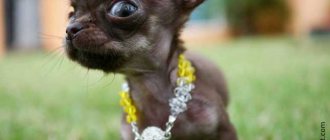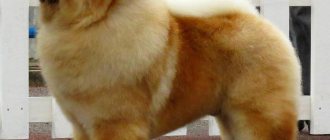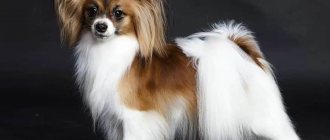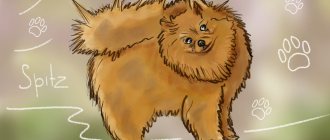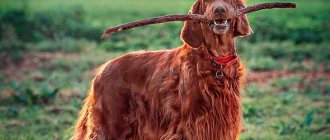When choosing a pet to keep in an apartment, every owner wonders what breed to buy.
Currently, you can find a dog of any size, character and classic character traits inherent in a particular breed. But if most animals are suitable for keeping in the yard, then for small city apartments you should select a four-legged pet more carefully.
- TOP 10 small dog breeds for apartments
- TOP 10 medium dog breeds for apartments
- TOP 10 large dog breeds for apartments
Important points when choosing a dog for an apartment
When looking for a four-legged companion to share in an apartment, most people adhere to the generally accepted opinion that the deciding factor in the choice should be its size.
The dimensions of the dog are, of course, important, but no less important are the temperament, physiology, and character traits of the breed to which it belongs. A German shepherd, for example, in a spacious apartment may not be immediately noticed, which cannot be said about a restless dachshund, busily scurrying from room to room with the intention of doing something “useful.” Some dogs from the indoor-decorative group, the name of which, in fact, contains their purpose, sometimes require more careful care than medium and large dogs that feel quite comfortable in a city apartment. Do not forget that representatives of dwarf breeds can easily be injured.
Pet size
Many dog lovers are skeptical about small breeds, considering only respectable dogs to be worthy company. Owners of spacious city apartments, where each household member has enough personal space, will certainly not be embarrassed by a medium or large pet. The living space will allow you to share square meters even with a very impressive dog, which solves the most important everyday issue regarding providing him with a personal place.
This should be a cozy, uncrowded corner with a bed where the dog can retire without fear that its peace will be disturbed. The bed should not be placed in a passage, in a draft or near a radiator, near closets or beds, where someone will certainly stumble upon a peacefully sleeping pet. It is clear that in small Soviet-style apartments the choice of a suitable resting place for a large dog is extremely limited. What can we say about the ability of such an animal to warm up, play, and simply move from one room to another without disturbing anyone. You can forget about a comfortable life in such conditions.
Miniature dogs need less spacious housing. Even in a small apartment, they will have enough space to run around, play, play pranks, and splash out their energy. For these kids, it is also necessary to arrange their own relaxation corner, although they usually prefer a sofa, armchair or the lap of their owners.
When deciding on the size of your future pet, it is worth taking into account the characteristics of the neighborhood in which you live. Medium and large dog breeds usually need long walks. The dog will be happy if there is a large park or forest plantation near the house, where the owner could let him off the leash without fear. It’s quite possible to take a lap dog for a walk in the yard or nearby park. In addition, many older people who find it difficult to regularly take their pet outside successfully train their babies to use the litter box.
Dog character and temperament
Even a well-trained, well-mannered pet retains the behavioral characteristics inherent in the breed to which it belongs. It is easier for service and fighting dogs to adapt to the conditions of limited space than for representatives of hunting breeds. The former are less active and, as a rule, have a reserved character. And the latter need an outlet for their ebullient energy, and if you do not provide them with physical activity, they are able to turn the entire apartment into a playground, especially when the owners are not at home.
It is important to ask how noisy your future companion may be. Representatives of a number of breeds tend to loudly notify the entire entrance about the return of the owner, while others will whine sadly non-stop when left alone. Such vocal performances are unlikely to earn the applause of neighbors, and it is quite difficult to wean pets from vocalizing. Most indoor dogs, as well as terriers, especially small ones, love to make noise.
Physiological nuances
In an apartment, especially a small one, the physiological characteristics of the breed can become a decisive factor when choosing a dog. So, not everyone will like to relax to the accompaniment of the snoring of a dog sleeping nearby. This feature is inherent in short-faced dogs - pugs, Pekingese, as well as bulldogs and boxers, which, moreover, often suffer from flatulence.
Some breeds have an indestructible dog smell. Its intensity can be reduced with proper care of the dog's coat, but this characteristic feature cannot be completely eliminated. People who are not ready to put up with such a “fragrant nuance” in the apartment should pay attention to almost odorless Bichons, Pekingese, Chihuahuas, poodles, Bedlington Terriers, Dalmatians, and rare hairless dogs.
Dogs with pronounced jowls (hanging lips) are characterized by increased salivation, so it is better for squeamish citizens not to choose a bulldog, boxer, sharpei, or St. Bernard as a pet.
Boston Terrier
This gentleman in a tuxedo is an active and loving dog. However, the Boston Terrier can be too smart for a dog, it is 4-11 kg of stubbornness, covered with a beautiful black and white coat. These dogs can sometimes be hyperactive. But they are so incredibly cute that all bad behavior is forgotten. Just look at those big round eyes! They adore their family and are extremely affectionate animals at home.
Their funny antics will keep all your friends entertained, as well as their snorting, drooling and flatulence. These dogs are generally calm, but if a male Boston Terrier's territory is invaded by another male, he will become very nervous.
- Care: average. Brushing weekly, and washing and checking eyes for redness or irritation daily.
- Noise level: low, except when another male is nearby.
- Friendliness: High, these dogs love children!
- Physical activity: average. They are fairly inactive indoors. The Boston Terrier can go outside and loves to play, but after an active time he will rest in the apartment for a long time.
Indoor decorative and other small breeds of dogs for apartments
This category includes dogs whose height at the withers does not exceed 40 cm.
Yorkshire Terrier
This dog is rightfully considered one of the best four-legged companions, ideal for apartment living. The dog has a serious character, inherited from its larger relatives. He is completely fearless, smart, active. Yorkies have the most tender feelings towards household members, and at the same time consider themselves the masters of the home. They are characterized by cleanliness and no dog smell. These beauties practically do not shed, and they are quite easy to train to the tray.
Yorkshire Terrier
Chihuahua
The smallest dogs on the planet are divided into long-haired and short-haired. Compared to other toy breeds, Chihuahuas are quite calm and balanced. However, this little one is very easy to get angry if a real or imaginary threat to his beloved owner appears. The most tender feelings for the owner of a Chihuahua are accompanied by excessive jealousy. A dog constantly needs manifestations of its owner's love, care, attention; loneliness is unbearable for it. Safe conditions must be created in the apartment for a fragile pet.
Chihuahua
French Bulldog
Loyal, affectionate, calm and at the same time brave, this miniature heir to fighting dogs does not need special care or long walks, but does require training. French bulldogs are very smart, they do not bark over trifles, but they will warn the owner about danger. It is worth considering that these dogs cannot tolerate heat at all, so you need to arrange a room in the apartment where it would be cool in the stuffy summer. It is better for neat and squeamish people not to have a representative of this breed, or at least not to let him reign in the bedroom: French bulldogs are prone to flatulence, often snore, and drool.
French Bulldog
Maltese (Maltese)
A charming long-haired representative of one of the oldest European breeds, she is a friendly and affectionate creature with a fairly docile character. However, when they try to raise lap dogs, they begin to act up. These dogs are characterized by excessive suspicion of strangers - at the sight of a stranger they usually burst into hysterical barking. Maltese are sociable, inquisitive, and able to easily adapt to the character of their owner. They love to eat delicious food, and it is not possible to train them to follow commands without a tasty reward. The silky straight coat of Maltese dogs is practically devoid of undercoat. Dogs hardly shed, but it is advisable to brush them daily.
Maltese (Maltese)
Russian toy terrier
Even in the most spacious apartment, this touching baby manages to fill the entire living space. Toy terriers are incredibly energetic, playful and playful. Anything can excite these dogs, but they are not easy to calm down. Those who choose this breed will often have to “enjoy” the boisterous bark of the animal. This drawback is offset by the incredibly positive energy of the toy terrier, which can improve the mood of any household member. The breed's strengths also include courage, ingenuity and exceptional memory.
Russian toy terrier
Pembroke Welsh Corgi
Extremely active and devoted favorites of the British royal family are the heirs of herding dogs. Instincts make themselves felt, and even in an apartment, corgis always try to settle in a “strategic position” that allows them to keep all household members under control. If one of the younger generation of his “herd” moves erratically, the Corgi may well lightly bite the offender on the leg or heel. This is not dangerous, but it is better to wean your dog off this habit immediately. Welsh Corgis have authoritative vocals - they bark no less loudly than their larger relatives. Owners have to put up with not only the expressive barking of their pet, but also the fact that he expresses his thoughts and demands by whining, grunting, sniffling and muttering. The corgi’s inherent “talkativeness” is offset by such advantages as love of life, fearlessness, endurance, agility, love for children and, of course, a charming appearance with a smiling face.
Pembroke Welsh Corgi
Pekingese
Smart, fearless and somewhat arrogant, Pekingese are one of the most popular representatives of indoor breeds. The main difference between this dog and most of its miniature relatives is its pronounced sense of self-esteem. Pekingese are independent, independent, do not claim constant attention from their owners and can easily tolerate loneliness. They will not disturb the peace of their owners with obsessive pestering and barking for no reason, which is why older people often choose them as companions. Pekingese treat their owners with love and respect, always feel their mood and behave accordingly. The former favorites of the Chinese emperors will not make a mess in the apartment, spoil the furniture and get underfoot. They are not very active and can easily do without regular walks. However, this is fraught with puddles on the floor - furry aristocrats do not favor litter boxes.
Pekingese
Pekingese
Photo: DavidDO/Depositphotos
- Height at withers: up to 20 cm.
- Weight: up to 5–5.5 kg.
- Average life expectancy: up to 12–15 years.
Pekingese are miniature dogs with an unusual and expressive appearance. You can’t call them too active, but they can’t do without daily walks - albeit leisurely and not too long.
Some difficulties may arise with upbringing and training due to the stubborn nature of such pets. Although the dogs are very loyal, absolutely non-aggressive and fearless, they get along well with children and adults.
Pekingese have a fairly long coat that requires constant care. The dog needs to be brushed daily; without this procedure, its appearance will quickly become unkempt.
Help the pet

